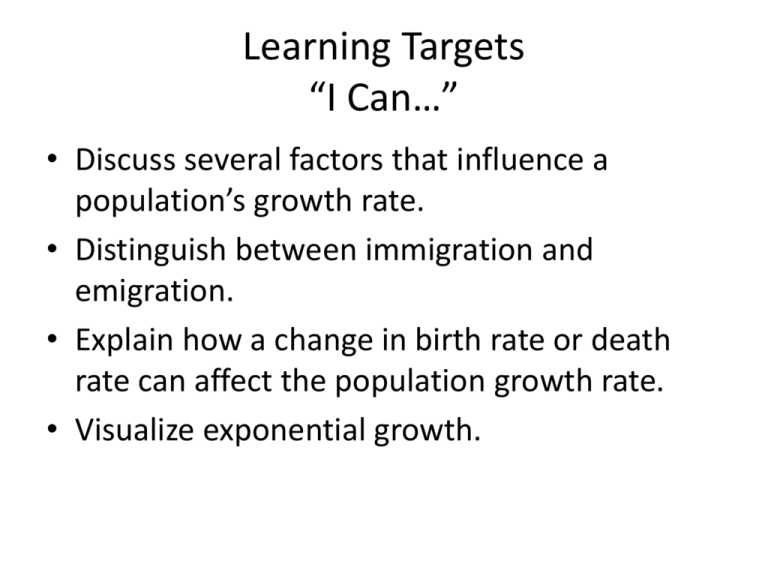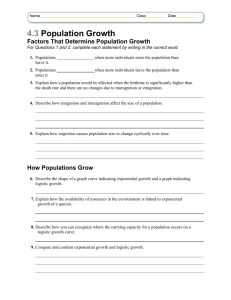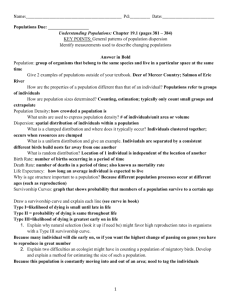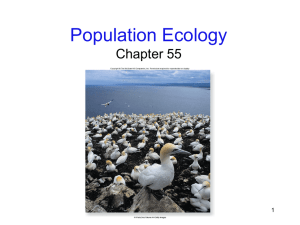Populations
advertisement

Learning Targets “I Can…” • Discuss several factors that influence a population’s growth rate. • Distinguish between immigration and emigration. • Explain how a change in birth rate or death rate can affect the population growth rate. • Visualize exponential growth. Populations Interdependence in Nature How Populations Grow Hydrilla verticillata • Native to Asia • Aquarium plant that was tossed into Florida waters by a fish farmer in 1950 • Began to reproduce quickly and take over waterways • Why did these plants get so out of control? How Populations Grow? New England Cod • Catch has dropped dramatically in recent years • In 1982, the catch was 57,200 metric tons; in a recent year it was only 3048 metric tons • Where did all the fish go? Describing Populations • Both the Hydrilla and the cod involve dramatic changes in population size over a period of time • What is a population? – A group of organisms of a single species that lives in a given area Describing Populations • Geographic Range: The area inhabited by a population Describing Populations • Population Density: the number of individuals per unit area Describing Populations • Population Distribution: how individuals in a population are spaced out across the range of the population Describing Populations – Uniform Distribution Describing Populations • Age Structure: the number of males and females of each age a population contains Population Growth • A population will increase or decrease in size depending on how many individuals are added to it or removed from it. • The factors that affect population growth are the birth rate, death rate, and the migration rate Population Growth Number of Times Napkin is Folded 0 1 2 3 4 5 6 7 8 9 10 11 Number of Napkin Layers Exponential Growth • Under ideal conditions with unlimited resources, a population will grow exponentially, where the size of each generation of offspring will be larger than the generation before it Exponential Growth Learning Targets “I Can…” -Derive a formula for exponential growth -Define “logistic growth.” -Draw/Interpret a graph for a population that is experiencing exponential growth. -Name the three phases of logistic growth and identify these three regions on a graph. -Define “carrying capacity.” -Explain what happens if a population reaches its carrying capacity. Exponential Growth Calculating Exponential Growth http://edweb.sdsu.edu/t2arp/quest/pop/Population_Growth.html Answer the following five Questions! 1. Predict phase 5, phase 6, phase 7? 2. How many people are there in phase ten, fifteen, and twenty? 3. Do you see a pattern? Explain. 4. At what phase does the growth seem large to you? Why? 5. Draw a simulation model, like the one above, for each mother having three babies. 6. Answer Questions 1-4 for the simulation in question 5. Logistic Growth • Naturally, populations do not grow exponentially for long, otherwise they would already cover the earth. There are actually phases of growth within populations – Phase 1: Exponential Growth – Phase 2: Growth Slows Down – Phase 3: Growth Stops and has reached its Carrying Capacity Logistic Growth Logistic Growth Learning Targets “I Can…” -Define “limiting factor” and give several examples of limiting factors in a population. -Distinguish between density-dependent and density-independent limiting factors and give several examples of each. -Interpret population growth curves for several different sample populations. -Establish symbiotic relationships by comparing the growth curves of two species. Limits to Population Growth • A limiting factor is a factor that controls the growth of a population • Limiting factors determine the carrying capacity of an environment for a species • Limiting factors keep most natural populations somewhere between extinction and totally overtaking the planet Limits to Population Growth • Density-Dependent Limiting Factors: factors that affect populations when the population density reaches a certain level; these factors do not generally affect small, scattered populations – Competition for resources – Predator/Prey relationships – Parasites and disease – Stress from overcrowding Limits to Population Growth • Density-Independent Limiting Factors: affect all populations in similar ways, regardless of population size and density – Unusual weather (hurricanes, droughts, floods) – Natural disasters (wildfires)








